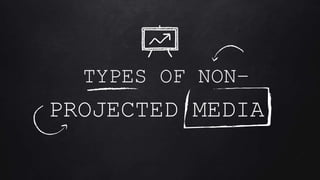Ilo non projected
- 1. PROJECTED MEDIA TYPES OF ą·°ŋą·ĻC
- 2. 1. Text / Print (Books, Journals, Modules) 2
- 3. ADVANTAGES ? Readily Available ? Flexible ? Economical 3
- 4. LIMITATIONS ? Reading level of learning ? Memorization ? Passive 4
- 5. UTILIZATIONS ? Direct student reading with objectives and/or questions. ? Emphasize the use of visuals with text-based materials. ? Supplement text with other media. 5
- 6. EXAMPLE 6
- 7. 2. Still Visuals 2.1 Printed Visuals 2.2 Displayed Visuals 7
- 8. 2.1 Printed Visuals (pictures, cartoons, chart, comic strips, flash cards, diagrams) 8
- 9. ADVANTAGES ? Readily Available ? Inexpensive 9
- 10. LIMITATIONS ? Two Dimensional ? Lack of Motion ? Different Interpretations 10
- 11. UTILIZATIONS ? Provide written or verbal cues to highlight important aspects of visuals. ? Use one visual at a time except for comparison. 11
- 12. EXAMPLE 12
- 13. EXAMPLE 13
- 14. 2.2 Displayed Visuals (chalkboard, bulletin board, flipchart, multipurpose boards ) 14
- 15. ADVANTAGES ? Multipurpose ? Colorful ? Participation 15
- 16. LIMITATIONS ? Commonplace ? Not portable ? Space 16
- 17. UTILIZATIONS ? Check the visibility of the board from several positions around the room. ? Decide in advance how you plan to use the board. 17
- 18. UTILIZATIONS ? Print using upper and lower case. Not all caps. ? Face your audience, do not talk to the board with your back to the class. 18
- 19. EXAMPLE 19
Editor's Notes
- -consists of all written materials -SELECTION : appropriateness of the material (lesson, age, content, vocabulary) : readability of text : screened for accuracy and free of bias (sex, religion, ethnic)
- materials are readily available in a range of topics and format portable and can be used in any lighted environment. Students can bring them home very easily can be used again and again by many students, can be created and duplicated with little expense
- some students are non readers or poor readers. Readers who lack pre requisite knowledge may find difficulty comprehending the text some critics say textbooks promote memorization rather than higher level of thinking skills others contend that text promotes solitary learning rather than cooperative group processes, tends to have one way communication
- Books : Periodicals/Newspapers Journals
- visuals provide a representation of verbal information Conveys authentic and clear message
- visuals are readily available in picture books, magazines, newspaper, catalogs and calendars, can easily catch attention. Inexpensive to produce or purchase and can be reused
- lacks the three-dimensionality of the real object or scene, fail to present scale size or perspective Static and cannot show motion Can easily get torn, distorted or lost Can portray different interpretations
- Flashcards : valuable material for drill activities, pictures, words, shape, numbers Comic Strip : drawings with exaggerated features that provide humor, important social and political comments Graph : represents and summarize numerical data, illustrate relationship among units of data types (line, bar, pie, pictograph, Diagrams : consist of lines and symbols that show relationship of key features of a process, an object or an area types (venn, cycle, radial, pyramid, target)
- Poster : intend to catch and hold viewers attention to present a brief persuasive message, can be prepared by teachers or students Cartoon : very popular and familiar, appeals to learners of all ages
- Can be instructional, motivational and decorative
- both students and teachers can use display boards for a variety of purposes provide color and add interest to classrooms or hallways students can benefit from designing and using display boards
- instructors often neglect to give display boards the attention and respect they deserve as instructional devices most display boards are not movable There may be only so much surface to use in the classroom to display art work or use for instruction
- Bulletin Board : inside and outside of the classroom, makes individual thinking available to the group and support knowledge-building. Can convey a variety of information Chalk Board : was most popular teaching medium until it was replaced by multimedia board Multimedia Board : white board, write/draw on it, post something, project Flip Chart : use to present information by turning one piece of paper at a time


















